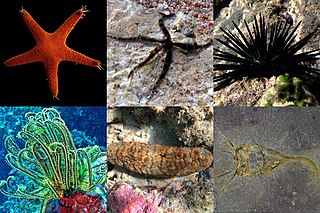
An echinoderm is any deuterostomal animal of the phylum Echinodermata, which includes starfish, brittle stars, sea urchins, sand dollars and sea cucumbers, as well as the sessile sea lilies or "stone lilies". While bilaterally symmetrical as larvae, as adults echinoderms are recognisable by their usually five-pointed radial symmetry, and are found on the sea bed at every ocean depth from the intertidal zone to the abyssal zone. The phylum contains about 7,600 living species, making it the second-largest group of deuterostomes after the chordates, as well as the largest marine-only phylum. The first definitive echinoderms appeared near the start of the Cambrian.

Starfish or sea stars are star-shaped echinoderms belonging to the class Asteroidea. Common usage frequently finds these names being also applied to ophiuroids, which are correctly referred to as brittle stars or basket stars. Starfish are also known as asteroids due to being in the class Asteroidea. About 1,900 species of starfish live on the seabed in all the world's oceans, from warm, tropical zones to frigid, polar regions. They are found from the intertidal zone down to abyssal depths, at 6,000 m (20,000 ft) below the surface.

Asterias amurensis, also known as the Northern Pacific seastar and Japanese common starfish, is a seastar found in shallow seas and estuaries, native to the coasts of northern China, Korea, far eastern Russia, Japan, Alaska, the Aleutian Islands and British Columbia in Canada. Two forms are recognised: the nominate and formarobusta from the Strait of Tartary. It mostly preys on large bivalve molluscs, and it is mostly preyed on by other species of starfish. Population booms in Japan can affect the harvest of mariculture operations and are costly to combat.
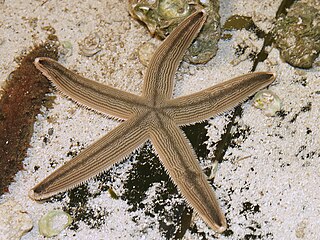
Luidia clathrata is a tropical species of starfish in the family Luidiidae. It is variously known as the slender-armed starfish, the gray sea star, or the lined sea star. It is found in the western Atlantic Ocean.
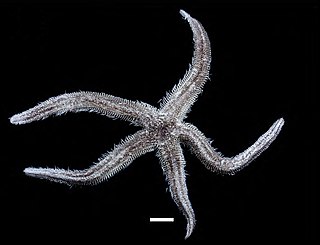
Luidia superba is a tropical species of starfish in the family Luidiidae. A single specimen was found off the Pacific coast of Colombia in 1888; the species has since been found in the Galapagos Islands. It is endemic to this area and has not been recorded elsewhere.
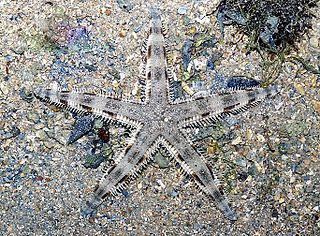
Archaster typicus is a species of starfish in the family Archasteridae. It is commonly known as the sand star or the sand sifting star but these names are also applied to starfish in the genus Astropecten. It is found in shallow waters in the Indo-Pacific region.
Anasterias rupicola is a species of starfish in the family Asteriidae. It is found in shallow waters in the Southern Ocean and sub-Antarctic Indian Ocean.

The Astropecten articulatus, more commonly known as the Royal Starfish, is a West Atlantic sea star of the family Astropectinidae.

Leptasterias polaris, the polar six-rayed star, is a species of starfish in the family Asteriidae. It is found in cold waters in the northwest Atlantic Ocean and in polar regions.
Ophidiaster granifer, the grained seastar, is a species of starfish in the family Ophidiasteridae. It is found in the Red Sea and the Indo-Pacific and is the only known species of starfish to reproduce by parthenogenesis.

Astropecten duplicatus, the two-spined sea star, is a starfish in the family Astropectinidae. It is found in the eastern Atlantic Ocean, the Caribbean Sea and the Gulf of Mexico.

Marthasterias is a genus of starfish in the family Asteriidae. Both species in the genus are commonly known as the spiny starfish.
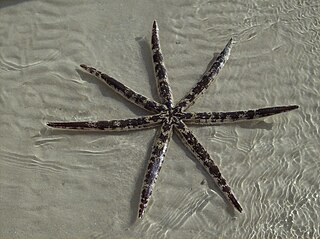
Luidia maculata is a species of starfish in the family Luidiidae in the order Paxillosida. It is native to the Indo-Pacific region. It is commonly known as the eight-armed sea star because, although the number of arms varies from five to nine, eight arms seems to be the most common.

Novodinia antillensis, the velcro sea star, is a species of starfish in the family Brisingidae. It is found in the deep sea in the tropical and subtropical western Atlantic Ocean, being quite common at a depth of around 500 m (1,640 ft) on the Mesoamerican Reef off Roatán, Honduras.
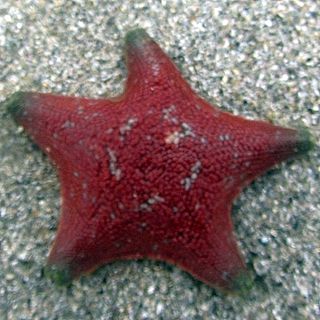
Patiria chilensis is a species of starfish in the family Asterinidae. It is found in the southeastern Pacific Ocean along the coasts of South America. It is a broadly pentagonal, cushion-like starfish with five short arms.

Stichaster striatus, the common light striated star, is a species of starfish in the family Stichasteridae, found in the southeastern Pacific Ocean. It was first described by the German zoologists Johannes Peter Müller and Franz Hermann Troschel in 1840.
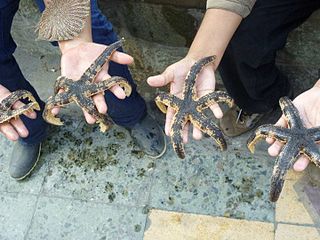
Luidia magellanica is a species of starfish in the family Luidiidae. It is found in the southeastern Pacific Ocean on the coast of South America.

Heliaster helianthus, the sun star, is a species of Asteroidea (starfish) in the family Heliasteridae. It is found in shallow water rocky habitats and in the kelp forests off the Pacific coast of Ecuador, Peru and Chile.

Tetrapygus is a genus of sea urchins in the family Arbaciidae. It is a monotypic genus and the only species is Tetrapygus niger which was first described by the Chilean naturalist Juan Ignacio Molina in 1782. It is found in the southeastern Pacific Ocean on the coasts of South America.

Anasterias antarctica, commonly called the Cinderella starfish, is a species of starfish in the family Asteriidae. It is found in coastal waters in the Southern Ocean and around Antarctica.


















